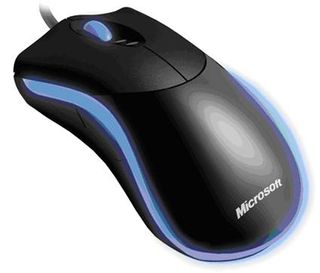Microsoft Breeds Four Unique Mice
First Impressions - Habu

Another big surprise is that Microsoft has developed a mouse jointly with Razer, the gaming mouse specialist - an area Microsoft had been neglecting for some time. The Habu is the first fruit of this collaboration. It uses the same laser-optics technology as Razer's Copperhead mouse, the most reactive mouse currently on the market. The sensor, made by Agilent, has a resolution of 2000 dpi, and is teamed up with the highly precise optics and accelerated coordinate reporting rate needed to keep the movement fluid despite the high speed.
The result is exceptional, since gamers get a mouse that's very fast but doesn't sacrifice accuracy. That also makes well suited for photo retouching, by the way. The main difference on the Microsoft mouse is the two buttons behind the scroll wheel that increase or decrease the resolution to suit the user's needs in a given situation. To give just one example, when you need to do a quick turn in a first-person action game, you need higher resolution and the accompanying speed. But if you have to aim with a rifle scope after you turn, you need precision, and that means you'd do well to lower the resolution a notch. On the Razer, you have to either turn the mouse over to get to the button that makes the change, or else perform a combined action with the scroll wheel - provided you've installed the appropriate driver. The two buttons on the Habu are much more convenient.
The Razer's flat, lean shape has been fattened up by Microsoft to become an ergonomic mouse for right-handers. The handling is also less aggressive, with the disappearance of the two rubber strips for grasping the mouse between the thumb and ring finger. This doesn't make the hand position passive, but it does improve comfort if you spend a lot of time playing online games. It's neither better nor worse, mind you - it's just a matter of personal preference. The mouse is still flat enough to guarantee quick hand movement.
Another new feature is that the two additional buttons on the left can be removed and replaced with two other ones that are positioned differently, so you can choose the combination that suits your hand best. It's a good idea, and one or the other arrangement ought to suit you, whereas on the Razer the additional buttons are poorly positioned. The scroll wheel and the two main buttons are the same as on the Razer, and they're excellent.
All of this adds up to making the Habu one of the best gaming mice around. It's as comfortable as the Logitech G5, but with a more active hand position that will please fans of networked FPS games. It's better equipped than the Razer Copperhead; as for the feel, whether you like it will really depend on your preferences. For more detail on some of the points I make here, see my review of the Razer Copperhead here.

Stay on the Cutting Edge
Join the experts who read Tom's Hardware for the inside track on enthusiast PC tech news — and have for over 25 years. We'll send breaking news and in-depth reviews of CPUs, GPUs, AI, maker hardware and more straight to your inbox.
-
dingumf "Wireless communication is via Bluetooth, which has several advantages. First, there's no latency, and the mouse operates perfectly even if you're several meters away - you'll notice no difference at all compared to a wired mouse. With the dongle provided, communication is established instantaneously."Reply
Are you retarded? YES THERE IS LATENCY. Why do you think Razer spent so much time on creating the Razer Mamba instead of using Bluetooth?
Bluetooth is no-where near a wired mouse and YES YOU WILL NOTICE THE DIFFERENCE. -
There is latency with this Bluetooth Mouse. I didn't notice it so much with the Microsoft Wireless 5000 bluetooth mouse, but occasionally notice it with the MS Presenter 8000 mouse, but only rarely, and that is when i have a lot of tabs open (45+ tabs) or CPU intensive. The advantages of the presenter mouse however out-way this minor disadvantage, but that's personal opinion. This is a great mouse, and lag/latency is almost non-existent, i've noticed various users of this mouse don't experience any latency anyway.Reply
Most Popular

